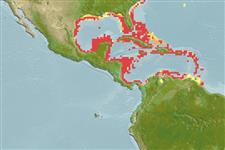>
Tetraodontiformes (Puffers and filefishes) >
Tetraodontidae (Puffers) > Canthigasterinae
Etymology: Canthigaster: Greek, kanthos = the outer or inner corner of the eye, where the lids meet, 1646 + Greek, gaster = stomach (Ref. 45335).
More on author: Bloch.
Environment: milieu / climate zone / depth range / distribution range
Ökologie
seewasser riff-verbunden; tiefenbereich 1 - 40 m (Ref. 43205). Tropical; 34°N - 8°N, 98°W - 59°W
Western Central Atlantic: South Carolina, USA and Bermuda to Tobago and the Lesser Antilles. All Canthigaster specimens so far recorded from Madeira belong to Canthigaster capistrata (Ref. 43205).
Size / Gewicht / Alter
Maturity: Lm ? range ? - ? cm
Max length : 12.0 cm TL Männchen/unbestimmt; (Ref. 26340)
Rückenflossenstacheln (insgesamt) : 0; Rückenflossenweichstrahlen (insgesamt) : 10 - 11; Afterflossenstacheln: 0; Afterflossenweichstrahlen: 9. Distinguished from all other Atlantic species by a short upper dark longitudinal stripe, presence of few spots on flank and dorsum, and absence of a conspicuous (larger than eye) spot on the dorsum. The upper dark longitudinal stripe extends from caudal-fin dorsal margin to the vertical through dorsal-fin base. Although a horizontal line of dark spots extends anterior to the anterior portion of the horizontal dark stripe in some specimens, and sometimes even surpasses the dorsal fin base, this line of spots never forms a continuous stripe. Also distinguished by the absence of vertically oriented bars on the caudal fin and by the presence of bars on the snout (Ref. 43205).
Inhabits reefs and marginal habitats such as seagrass beds (Ref. 43205). Diet consists of seagrass, sponges, crabs and other crustaceans, mollusks, polychaete worms, sea urchins, starfishes, hydroids and algae (Ref. 13442). Monogamous (Ref. 52884).
Life cycle and mating behavior
Geschlechtsreife | Fortpflanzung | Ablaichen | Eier | Fecundity | Larven
Oviparous (Ref. 205). No parental care according to Ref. 38836.
Moura, R.L. and R.M.C. Castro, 2002. Revision of Atlantic sharpnose pufferfishes (Tetraodontiformes: Tetraodontidae: Canthigaster), with description of three new species. Proc. Biol. Soc. Wash. 115(1):32-50. (Ref. 43205)
IUCN Rote Liste Status (Ref. 130435: Version 2024-2)
Bedrohung für Menschen
Harmless
Nutzung durch Menschen
Fischereien: kommerziell; Aquarium: Kommerziell
Tools
Zusatzinformationen
Download XML
Internet Quellen
Estimates based on models
Preferred temperature (Ref.
123201): 23.6 - 28, mean 26.4 °C (based on 220 cells).
Phylogenetic diversity index (Ref.
82804): PD
50 = 0.5000 [Uniqueness, from 0.5 = low to 2.0 = high].
Bayesian length-weight: a=0.03631 (0.01554 - 0.08482), b=2.88 (2.69 - 3.07), in cm total length, based on LWR estimates for this Genus-body shape (Ref.
93245).
Trophic level (Ref.
69278): 3.3 ±0.1 se; based on diet studies.
Widerstandsfähigkeit (Ref.
120179): hoch, Verdopplung der Population dauert weniger als 15 Monate. (Preliminary K or Fecundity.).
Fishing Vulnerability (Ref.
59153): Low vulnerability (10 of 100).
Nutrients (Ref.
124155): Calcium = 102 [47, 253] mg/100g; Iron = 0.966 [0.474, 2.280] mg/100g; Protein = 18.2 [16.0, 20.4] %; Omega3 = 0.133 [0.065, 0.262] g/100g; Selenium = 35.1 [17.1, 79.4] μg/100g; VitaminA = 52.6 [14.7, 200.9] μg/100g; Zinc = 1.59 [1.01, 2.41] mg/100g (wet weight);
